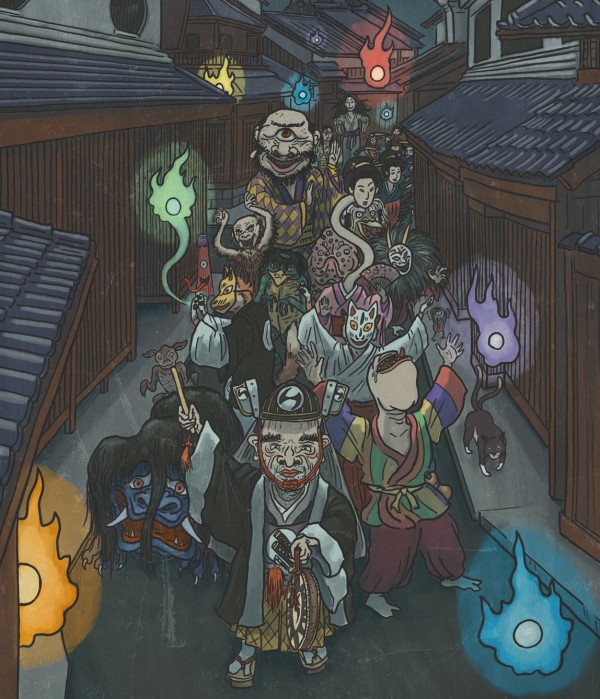It’s late and I know some of you have been waiting all day for this, so finally here it is! Of all the yokai I’ve painted, the largest number of them come from Kyushu and West Japan. Up to now, I’ve only done one yokai native to Okinawa — the Kijimunaa — and so I thought it was time to give a little more love to Ryukyu and the southern islands. | これまで九州と西日本の妖怪は沢山描いてきましたが、沖縄の妖怪は一つ(キジムナー)しか描いていませんでした。そこで、今回はさらにもう一つ琉球の妖怪を紹介したいと思います。 Continue reading
Tag Archives: A-Yokai-A-Day
A-Yokai-A-Day: Tatsu | 妖怪シリーズ:龍
Today’s yokai will be familiar to anyone anywhere, regardless of whether you’ve been to Japan or not: the dragon! It’s one of the most iconic images in Asian art — or pretty much any culture anywhere in the world. However, the Japanese dragon has some very unique features that set it apart from dragons in other cultures. Here is the tatsu entry from Night Parade: | 今日の妖怪は日本ではとても有名でどこに行っても誰でも知っているでしょう。世界でもドラゴンはとても有名ですが、日本の龍はとても独創的です。こちらはNight Parade本からの龍です。 Continue reading
A-Yokai-A-Day: Komainu | 妖怪シリーズ:狛犬
Today we kick of A-Yokai-A-Day for the month of October (2012 edition)! I wanted to start with a few well-known yokai, some of which are featured in my book. So today’s yokai is an excerpt from The Night Parade of One Hundred Demons, featuring a very common creature found all over Japan: the komainu! If you have ever visit a Shinto shrine or Japan, or even just seen a photo of one, most likely you are familiar with the lion-dog guardian statues, but what exactly are they?… | Today we kick of A-Yokai-A-Day for the month of October (2012 edition)! I wanted to start with a few well-known yokai, some of which are featured in my book. So today’s yokai is an excerpt from The Night Parade of One Hundred Demons, featuring a very common creature found all over Japan: the komainu! If you have ever visit a Shinto shrine or Japan, or even just seen a photo of one, most likely you are familiar with the lion-dog guardian statues, but what exactly are they?… Continue reading
Announcing A-Yokai-A-Day for the Month of October, 2012 Edition! | 2012年の妖怪シーリズ
Only 2 more days until October! And that means only two more days until yokai! In celebration of Halloween, I will be showcasing Japanese folkloric monsters, known as yokai, on this blog, with illustrations and English descriptions of creatures that are generally not known outside of the Japanese-speaking world. And what’s more, there will be a contest!!
About the Project
A-Yokai-A-Day began in October of 2009, in celebration of Halloween. I wanted to showcase something purely Japanese, yet also scary, and so when I came across yokai I knew they would be the perfect subject. Of course, back then, I didn’t know how big a door I was opening up — that it would lead to such a big fan reaction, many more years of painting yokai, numerous gallery shows, and the book, The Night Parade of One Hundred Demons, which was published earlier this year.
This year’s project will feature yokai from Night Parade, as well as some new yokai which have not been featured on this site or in the book before. (In fact, I’m pretty sure some of them have never even been featured in English before!)
I will also be selling giclée prints of each day’s yokai, printed in tradition oban size (the standard size done by the masters of Japanese woodblock prints), so if you like any of the illustrations, you can help support my artwork by buying a print!
But Wait, There’s More!
And now on to the most exciting part: the contest! At the end of the project, on Halloween, I will be giving away an A1-sized poster from my August gallery show to one lucky yokai fan. Here’s the poster:
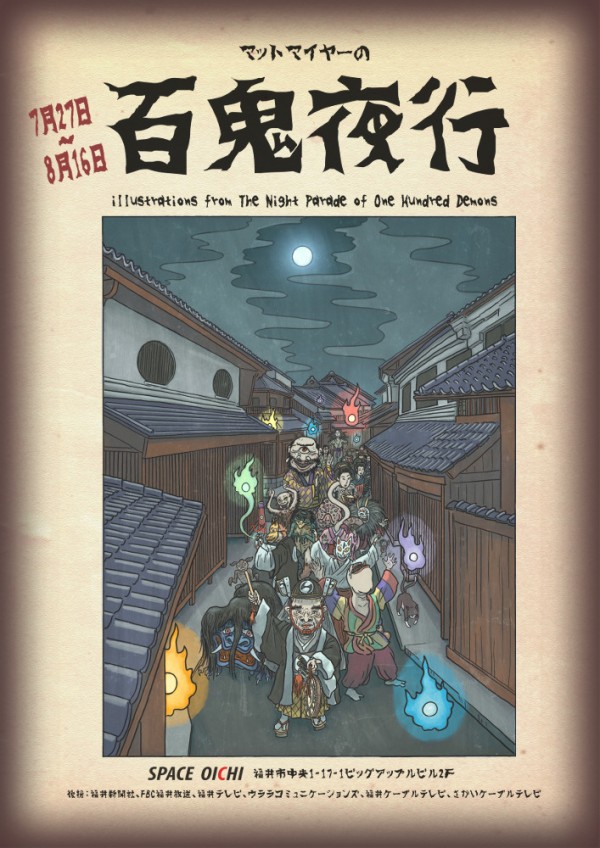
Hyakki Yagyou, the Night Parade of One Hundred Demons
For a chance to win, you only need to do one thing: name ALL of the yokai in that poster! It may sound easy, but it’s much harder than you think! To give you some help, here is a close-up of the yokai in the image so you can see them better:
Here is one more hint: there are 22 yokai in the picture. Also, while most of them are slightly obscured and hard to see, one of them in particular will be very tricky to guess! However, all of them are in my book, and almost all of them have been shown on this site in the past. You can also browse through the photos on my Facebook page to see all of the illustrations from Night Parade (that might help you guess all of them but the very tricky one…). Okay, NO MORE HINTS!
Now you’ve got a month to think about it, search around, Google it, so don’t rush! I’ll post details on how to submit your answers later in October. The lucky winner will be chosen at random out of all the correct answers on October 31st. | 10月です。今年もハロウィーンシーズンがやってきました!
A-Yokai-A-Day2012 Editionが始まります!
とうとう10月が始まりました。まだ日本以外ではまだあまり知られていない日本の妖怪をこのブログで紹介していきます。後に大きなお知らせもありますので楽しみにしていてくださいね。
このプロジェクトについて
A-Yokai-A-Day(日本語では「今日の妖怪」として紹介しています)は2009年の10月にハロウィーンにちなんで始めたのがスタートです。何か日本にちなんだ怖いものを紹介しようとリサーチをした所、妖怪にたどり着きました。この時私は後々こんなに大きなプロジェクトになるとは気がついていませんでした。このプロジェクトを始めてから本当に沢山の妖怪ファンの方々と出会いましたし、展示会もやらせていただいたりして妖怪の本The Night Parade of One Hundred Demonsを出版する事までできました。
今年の妖怪達は、この「Night Parade」本からのものと、その他にもさらに新しい妖怪を紹介したいと思います。そしてさらに、紹介した妖怪絵の大判サイズのプリントも購入できるようにいたしますので、もし私の絵が気に入っていただけたら私の画家活動のサポートのためにもご協力よろしくお願いします。
さらにもう一つお知らせです!
今回のプロジェクトの終盤、ハロウィーンの日にコンテストをします!そしてこのコンテストに勝った方には、8月の展示会でおなじみのA1サイズのポスターをプレゼントします!

Hyakki Yagyou, the Night Parade of One Hundred Demons
勝者の条件は一つだけ。このポスターに描かれている妖怪全て答えるだけです!簡単なように思われるかもしれませんが、実はとっても難しいですよ!
ちょっとヒントを出しましょう。下のイメージはクローズアップしたものです。これでもうちょっと良く見えますね。
ではここでもう一つヒントです。ここには22の妖怪が描かれています。そしてほとんどの妖怪はちょっと不明瞭に描かれているのでちょっとわかりにくいですが、中でも一つは特にひっかけ問題になっています!でも、全ての妖怪は私の本の中にいますし、ほとんどは過去にこのブログでも紹介していますよ。
私のフェイスブックページでも本の妖怪ができいますので、これもヒントになるかと思います。
ではここでヒントは終わりです!
締め切りまで一カ月間考えたり調べたりする期間がありますのでじっくり考えてみて下さいね。
期限が迫ってきたら10月末にどうやって応募するかをお知らせします。幸運な
勝者は応募者の中から抽選の末10月31日に発表いたします。
2010 A-Yokai-A-Day Lineup
I’ve been enjoying my return to a normal sleeping pattern and 3 meals a day, and this past week has been so relaxing compared to the previous month! But I almost got carried away with my leisure and forgot that I have a website to maintain! I’ll post a few updates with new artwork and photos of some cool local places this week, but for now, for your viewing pleasure, I thought I would do a month-in-review post just to have easy access to all of the yokai. I realize it can be a bit of a pain to scroll through pages of my blog looking for the yokai you want to read about. (Hmmm… now that I have a bit of free time maybe I can do some site design…)
Also, the Japanese translations of the yokai are still being worked on, so please be a bit more patient if you’re waiting for them! A couple of the posts got to be so long-winded that translating them is proving much more difficult!
 |
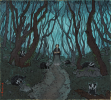 |
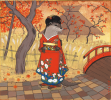 |
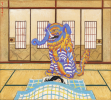 |
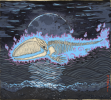 |
 |
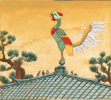 |
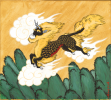 |
 |
 |
 |
 |
 |
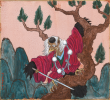 |
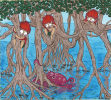 |
 |
 |
 |
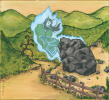 |
 |
 |
 |
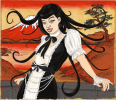 |
 |
|
 |
 |
 |
||
 |
 |
 |
Matted, fine art prints of each of these images are available from my Etsy page, and some of the originals are still available. If you’re interested in one of the originals, please send me an email using the contact form.
I will continue to paint more yokai throughout the year, though not on a daily basis, so remember to keep checking back here, or you can subscribe to my site via RSS, Facebook, or Google Friend Connect.
A-Yokai-A-Day: Oiwa (The Ghost Story of Yotsuya)
We’ve made it! The final A-Yokai-A-Day painting for October 2010! For Halloween I wanted to present something special. Today I bring you the story of Japan’s scariest and most famous ghost of all time! Tokaido Yotsuya Kaidan, the Japanese name of this story, is by far the most popular, most well known, and most terrifying of Japan’s ghost stories. It is a tale of love, betrayal, murder, and revenge. Despite its age, Yotsuya Kaidan makes even today’s ghost stories seem a timid. The ghost story was created by combining and adding some fiction to two contemporary real-life murder stories and adapting them into a single kabuki show. (The first involved two servants who had murdered their respective masters; they were caught and executed on the same day. The second murder was from a samurai who discovered his concubine was having an affair with a servant; the samurai had the faithless concubine and servant nailed to a wooden board and thrown into the Kanda River.) The show became an instant success and went down in history as Japan’s most popular play ever. Since then it has been reproduced into every form of media imaginable, including over 30 movies. Not only that, the influence of the story on Japan’s culture was so strong that every Japanese ghost story since has borrowed from the powerful imagery and mythology in this story, and you can see its direct influence in today’s well-known ghost stories like Ju-On/The Grudge and Ringu/The Ring and their many spin-offs. Even Chinese, American, and other countries’ ghost stories are now taking their imagery from Yotsuya Kaidan (indirectly via the Japanese hit movies which were inspired by it).
Oiwa (The Ghost Story of Yotsuya)
A long time ago in the area of Tokyo known as Yotsuya there was a masterless ronin samurai named Iyemon. He wished to marry a beautiful woman named Oiwa, but her father, Samon, had heard of Iyemon’s past misdeeds and refused to allow him to marry his daughter. Iyemon’s servant Naosuke also wished to marry Oiwa’s sister Osode, who was unfortunately already married to a man named Yomoshichi. So Iyemon and Naosuke conspired to murder Oiwa’s father and his servants, and Osode’s husband. In order to win Oiwa’s and Osode’s marriages, they claimed that a local bandit had done the killings and promised that they would avenge their deaths. The women agree to marry them.
Time passes, and Oiwa bears Iyemon a son. But she grows sickly and weak after giving birth and never completely recovers. Iyemon is forced into lower work in order to support his family, and he grows to strongly resent his invalid wife. Soon, Iyemon falls in love with another woman, Oume, who is the granddaughter of a rich doctor. Iyemon schemes to murder his wife with Oume, and Oume recieves some poison from her grandfather, and gives it to Iyemon who in turn delivers it to Oiwa, telling her that it will make her stronger. Oiwa takes the medicine and grows weaker and weaker, but it does not kill her. Rather, it disfigures her face, causing her eye to sag her skin to scar over and bleed, and her hair to fall out in bloody clumps.
Meanwhile, Naosuke and Osode are married, but despite his numerous advances, she keeps refusing his attempts to consummate the marriage.
Iyemon, grown disgusted by Oiwa’s mangled face, then bribes a local man named Takuetsu to rape Oiwa so that Iyemon will have grounds to divorce her. Takuetsu attempts to do so, but is unable due to the way she looks. Instead, he shows Oiwa her own reflection in a mirror, and Oiwa grows furious. She rushes to kill Takuetsu with a sword, and he tries to block her. Oiwa trips and cuts her own throat open with the sword. Bleeding to death, she kills her infant son so that he will not be raised by Iyemon, and she curses her husband’s name with her dying breath. One of Iyemon’s servants, Kohei, becomes aware of the murder. To silence Kohei, Iyemon murders him, and nails the bodies of Oiwa and Kohei to a board, and drops them into a river. He claims the two were having an affair, and he is released from his marriage.
Iyemon and Oume arrange to be married. On their wedding night, Iyemon sees a vision of Oiwa’s ghost. He slashes at her, cutting off her head, but then the vision clears and he realizes he has just murdered his new wife Oume. Terrified, he rushes to his new father-in-law’s house, where he sees a vision of Kohei. He attacks his ghost as well, and ends up murdering his father-in-law too.
Iyemon then works to purge his now-dead second wife’s family, throwing his mother-in-law into a canal, and drowning their servants. His friend Naosuke continues to pressure Osode to consummate the marriage, but she oddly continues to refuse. Around that time, Yomoshichi returns, having not actually been killed, and accuses Osode of adultery. She is shamed, and resigns to an honorable redemption in death. She begs her two husbands to kill her, and they gladly oblige. Her final act, though, is to leave a note to her husband Naosuke informing him that she was actually his own younger sister. Shamed, Naosuke commits suicide as well — but not before Yomoshichi acquires damning evidence against Iyemon from him.
Meanwhile, Iyemon flees, constantly pursued by the ghosts of the people he has killed. Oiwa’s ruined face follows him everywhere, even appearing (famously) in a paper lantern. He flees to the mountains, but when he goes fishing, instead of fish, he pulls out the board with Oiwa’s and Kohei’s bodies nailed to it. He flees to a cabin, where the vines from the trees and the smoke from the fire transform into Oiwa’s hair and try to ensnare him.
Finally, Iyemon flees his cabin, having lost his mind and descended into madness as his nightmares become his reality. He runs into Yomoshichi, who slays Iyemon out of both pity and vengeance.
Her story doesn’t end there, though. She continues to haunt even today. From my post on onryo last year you may remember that Japanese ghosts, unlike Western ghosts, don’t go away after they are put to rest. There is generally no end to their haunting. And Oiwa, being the most horrible ghost in Japan is certainly no exception.
Oiwa’s body is buried at a temple (Myogo-ji) in Sugamo, Tokyo, and the date of her death is listed as February 22, 1636. There have been numerous reports of accidents, injuries, and even deaths surrounding productions of the play Tokaido Yotsuya Kaidan, and even during TV and movie productions of the story. As a result, there is said to be a famous curse that touches anything and everything related to this story (like the MacBeth curse, only worse). Nowadays, it is customary before starting any movie or TV show that even talks about Oiwa’s story for the principal actors and the director to make a pilgrimage to Oiwa’s grave and ask her permission to perform and for her blessing for their production. Imagine if you were supposed to play the role of Oiwa!! (Incidentally, I did not go to Tokyo prior to writing this, so if anything happens to me in the coming days…)

Oiwa
There you have it, the number one ghost story in Japan! I hope it makes your Halloween a special one!
Okiku is the final yokai in this year’s A-Yokai-A-Day series. But that doesn’t mean I am done painting yokai! I will continue to paint and post yokai throughout this next year. I am now working on an illustrated book of yokai which will include a number of yokai from my A-Yokai-A-Day projects, as well as additional ones I have not yet posted. So stay tuned for more information on that! Remember, you can subscribe to my site via RSS feed, Facebook, Google Friend Connect, or by following @matthewmeyerart on Twitter to stay on top of all of my artwork and blog posts.
Finally, starting tomorrow, the remaining yokai from this series will become available on my Etsy store. You can help support the project as well as own a very special piece of Japan in your own home by visiting osarusan.etsy.com.
Have a Happy Halloween, and thanks so much for clicking back here every day this month!
A-Yokai-A-Day: Okiku (The Dish Mansion at Bancho)
I’ve been having a great time watching the Rally to Restore Sanity and/or Fear live while painting tonight’s ghost. I wish I could be there in person!
Okiku (The Dish Mansion at Bancho)
Today’s character comes from another very very famous kaidan ghost story called Bancho Sarayashiki, or “The Dish Mansion at Bancho.” Her name is Okiku, and she is one of the most famous ghosts in Japanese folklore. Her story has been adapted into puppet theater, kabuki, movies, ukiyo-e and every other imaginable art form. Her story takes place in the area of Bancho, in present-day Hyogo prefecture, but it has been adapted to other locations, and tweaked, and changed, so there are a number of different versions. The one I will tell you now is the more folkloric and traditional one.
A long time ago in the town of Bancho there was a beautiful woman named Okiku. Her master was a samurai named Aoyama, and he fell deeply in love with her. Every day her would ask her to be his mistress, but she always refused his advances, preferring the life of a servant girl to the life of a concubine.
Eventually, Aoyama makes his final advance on Okiku, but again she refuses, so Aoyama decided to trick her. He hid one of his family’s best dishes, which — as a servant — Okiku was supposed to be in charge of. When Okiku was counting the dishes later, she noticed that there were only nine instead of ten. She counted and counted again, but each time only came up nine. Okiku panicked, as losing one of these valuable objects would mean — quite literally — her life. She fell into despair.
She went to her master in tears to confess that she lost one of the dishes. All part of his plan of course, Aoyama told her that he would be gracious enough to overlook the problem if she finally agreed to be his lover. Okiku refused, and Aoyama grew enraged. He threw her down a well, and she died.
After her death, it is said that Okiku became an onryo — a vengeful Japanese ghost. She tormented her former master by counting and counting from one to nine and then shrieking a horrible scream. Aoyama was finally able to exorcise her ghost by having another servant wait until she reached number nine and then suddenly shout, “TEN!” After that, it is said that Okiku stopped haunting him.
The story doesn’t end there, because Japanese ghosts rarely find peace! Where she went next is unknown, but there are tales of Okiku all over Japan. It is said that she appears crawling out of a well and counts, ever searching for her missing tenth plate. Anyone who hears her count all the way up to nine will die. If you manage to escape and only hear up to eight, you may end up just with a debilitating disease. Either way, if you happen to hear a mysterious voice counting somewhere nearby, I suggest you get the hell out of there!

Okiku
Okiku prints will be available on my Etsy store in just a couple of days! So check back soon!

